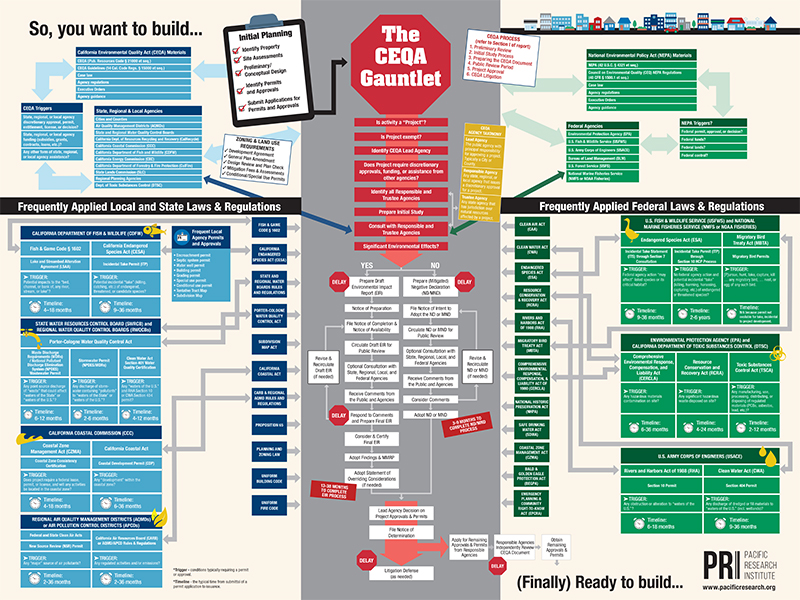In response, state lawmakers passed AB130 and SB131 this session, a package of bills which exempted various housing developments from California Environmental Quality Act (CEQA) review and provided streamlined review for developments which would have qualified for exemption but for one disqualifying condition.
Luis Quiñonez, President of the California Foundation for Commerce and Education, heralded the passage of AB130 and SB131 as ‘monumental political achievements,’ but pointed out that CEQA itself hasn’t been modernized since it was first signed into law by then-Governor Ronald Reagan in 1970.
Last month, the California Chamber of Commerce announced a ballot initiative to do just that, by establishing new timelines for ‘essential’ infrastructure projects concerning water, energy, transportation, and housing. John Myers, Senior Vice President at the Cal Chamber, describes the ballot initiative, entitled the ‘Building an Affordable California Act,’ as the first real attempt at ‘CEQA reform,’ arguing that previous efforts have focused on providing exemptions under the law rather than scrutinizing its language.
While California’s commitment to environmentalism is admirable, Myers believes the State has lost sight of how tedious the process of determining environmental impacts has become. ‘Everybody in the business world will tell you the process is the question, not the outcome.’ Thus, Myers presents the initiative as one that would provide much needed clarity and certainty to business in a timely manner, even if a project itself is denied.
The initiative would require local agencies to determine within 30 days if a project application is complete and would give them a further 30 days to determine the type of environmental review document necessary. Depending on the type of review required, the agency would have either 365 or 180 days to certify the environmental review. Failure to meet that deadline would trigger applicants’ option to hold a public hearing on the project.
‘Under existing law, while 30 day reviews for application completeness exist, agencies often request multiple rounds of edits, with no clear finish line. The back and forth over application completeness could drag on anywhere between six months to over a year,’ according to Quiñonez. Confident that the ballot initiative would expedite resolutions for any disputes, he estimates that for a housing project with no litigation, development under the initiative would be accelerated by 1-3 years. As applied to the energy industry, clean energy projects would similarly get underway 2-6 years earlier.
The initiative also takes aim at ‘frivolous lawsuits’ filed under CEQA that derail projects on procedural grounds, by forbidding Courts from issuing temporary injunctions in the absence of ‘clear and convincing evidence that an essential project would have a specific, adverse impact upon public safety.’ Additionally, any lawsuit would have to be filed within 30 days of an application being approved and resolved within 270 days under an expedited process of judicial review. By raising the bar for litigants and establishing a short timeline for legal challenges, Quiñonez believes the initiative would accelerate construction for housing development subject to litigation by at least four years.
Will the request be successful, and would the ballot measure command a majority of votes? It is too soon to say, but Quiñonez and Myers are quietly optimistic. As conversations concerning affordability continue to dominate Sacramento, the Chamber is confident that a variety of interest groups will rally around their efforts to streamline CEQA’s archaic and arcane processes.
Though the ballot initiative imposes uniform timelines on local agencies across the State, Quiñonez is confident that local government champions will support it nonetheless. He pointed out that the League of Cities was consulted during the drafting phase, and after substantive conversations with city leaders, it was clear that they too preferred a streamlined process for new developments. He also noted that at every step of the process, local agencies may deny projects should they choose. Environmentalists similarly have little to worry about, because the initiative honors the State’s environmental standards and doesn’t roll back key environmental protections.
AB130 and SB131 may positively impact housing development, but Quiñonez believes this initiative has the potential to unlock construction in a variety of critical areas by providing, for example, critical healthcare infrastructure for rural Californians and improved broadband connectivity across the State. In the process, Myers anticipates the creation of thousands of well-paying public works jobs that would boost the economy. Politics is a game of trade-offs, and no policy will be perfect. In filing this request, however, the Chamber is confident their initiative will usher in a brighter future for development in California, while simultaneously preserving the environmental soul of the state.
Nikhil Agarwal is a research associate at the Pacific Research Institute.

